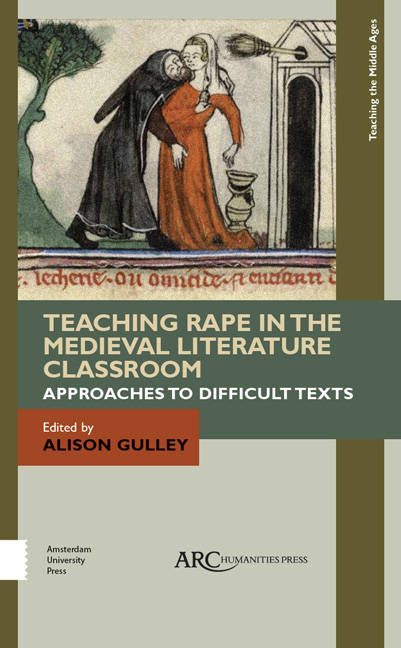Book contents
- Frontmatter
- Contents
- Acknowledgements
- Chapter 1 Introduction: Teaching Rape and Meeting the Challenges of the TwentyFirstCentury Classroom
- Chapter 2 Medieval Saints and Misogynist Times: Transhistorical Perspectives on Sexual Violence in the Undergraduate Classroom
- Chapter 3 Teaching Medieval Rape Culture across Genre: Insights from Victimology
- Chapter 4 Bringing the Bystander into the Humanities Classroom: Reading Ancient, Patristic, and Medieval Texts on the Continuum of Violence
- Chapter 5 From Bystander to Upstander: Reading the Nibelungenlied to Resist Rape Culture
- Chapter 6 Speech, Silence, and Teaching Chaucer’s Rapes
- Chapter 7 Classroom PSA: Values, Law, and Ethics in “The Reeve’s Tale”
- Chapter 8 “How do we know he really raped her?”: Using the BBC Canterbury Tales to Confront Student Skepticism towards the Wife of Bath
- Chapter 9 Teaching the Potiphar’s Wife Motif in Marie de France’s Lanval
- Chapter 10 Sexual Compulsion and Sexual Violence in the Lais of Marie de France
- Chapter 11 Troubadour Lyric, Fin’amors, and Rape Culture
- Chapter 12 The Knight Coerced: Two Cases of Raped Men in Chivalric Romance
- Chapter 13 Teaching Rape to the HeMan Woman Haters Club: Chrétien de Troyes at a Military School
- Chapter 14 Rape, Identity, and Redemption: Teaching “Sir Gowther” in the Community College Classroom
- Notes on Contributors
- Index
Chapter 7 - Classroom PSA: Values, Law, and Ethics in “The Reeve’s Tale”
Published online by Cambridge University Press: 23 January 2021
- Frontmatter
- Contents
- Acknowledgements
- Chapter 1 Introduction: Teaching Rape and Meeting the Challenges of the TwentyFirstCentury Classroom
- Chapter 2 Medieval Saints and Misogynist Times: Transhistorical Perspectives on Sexual Violence in the Undergraduate Classroom
- Chapter 3 Teaching Medieval Rape Culture across Genre: Insights from Victimology
- Chapter 4 Bringing the Bystander into the Humanities Classroom: Reading Ancient, Patristic, and Medieval Texts on the Continuum of Violence
- Chapter 5 From Bystander to Upstander: Reading the Nibelungenlied to Resist Rape Culture
- Chapter 6 Speech, Silence, and Teaching Chaucer’s Rapes
- Chapter 7 Classroom PSA: Values, Law, and Ethics in “The Reeve’s Tale”
- Chapter 8 “How do we know he really raped her?”: Using the BBC Canterbury Tales to Confront Student Skepticism towards the Wife of Bath
- Chapter 9 Teaching the Potiphar’s Wife Motif in Marie de France’s Lanval
- Chapter 10 Sexual Compulsion and Sexual Violence in the Lais of Marie de France
- Chapter 11 Troubadour Lyric, Fin’amors, and Rape Culture
- Chapter 12 The Knight Coerced: Two Cases of Raped Men in Chivalric Romance
- Chapter 13 Teaching Rape to the HeMan Woman Haters Club: Chrétien de Troyes at a Military School
- Chapter 14 Rape, Identity, and Redemption: Teaching “Sir Gowther” in the Community College Classroom
- Notes on Contributors
- Index
Summary
As a medievalist, I sometimes find myself encountering the assumption that the issues raised in the texts I study and teach are radically divorced from the concerns of our present day. This is, of course, nonsense, as the controversy surrounding an episode of Game of Thrones illustrated with explosive fervour. In 2014, director Alex Graves adapted a scene from George R. R. Martin's novel A Storm of Swords that enraged many viewers by apparently transforming an act of consensual sex between characters Cersei and Jaime into a rape. The director and other viewers objected to the viral explosion of criticism about the episode, insisting that the scene as filmed was not a rape at all. Some online commenters intervened into this debate with the opinion that the scene as written in Martin's novel depicted a male rape fantasy that the television version showed more explicitly to be rape. The sexual violence inherent to the fictional world of the show claims a kind of authenticity in its selective cultural mimicry of the violence and patriarchy associated with the medieval world. And indeed, for me the controversy resonated with the Chaucer class I was teaching at the time on women's consent.
Was this scene a rape? Such a question, asked of Geoffrey Chaucer's “The Reeve's Tale,” has likewise generated its share of critical controversy. When our texts— literary or visual, ancient or contemporary with us— depict troubling sexual scenes, we have an opportunity to help our students engage the process of making decisions about difficult issues. Rape, as well as other forms of violence against women, is inherently a difficult subject. The question, for example, of what precisely happened between Geoffrey Chaucer and Cecily Chaumpaigne that culminated in the exchange of ten pounds and her official release of him from culpability in the matter of her “raptus”— variously understood in the medieval period as “rape” and “abduction”— has been troubling scholars since the release's discovery. In response to scholars’ attempts to figure out whether the act between Chaucer and Chaumpaigne was or was not a rape, Christopher Cannon cogently argues that it would be difficult for us to make such a determination even if we knew more details. “Sexual violence,” Cannon observes, “is itself a crime where … the very act that might constitute the crime can be variously defined even by those who have identical ‘facts’ in hand.”
- Type
- Chapter
- Information
- Teaching Rape in the Medieval Literature ClassroomApproaches to Difficult Texts, pp. 91 - 112Publisher: Amsterdam University PressPrint publication year: 2018



